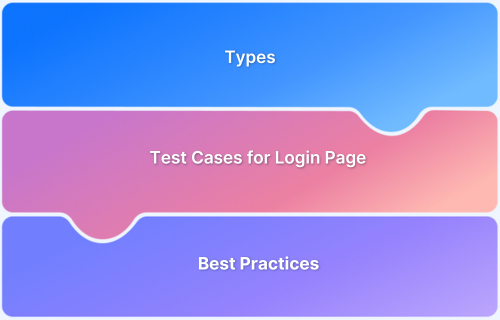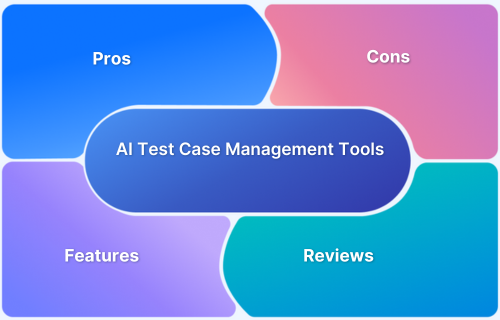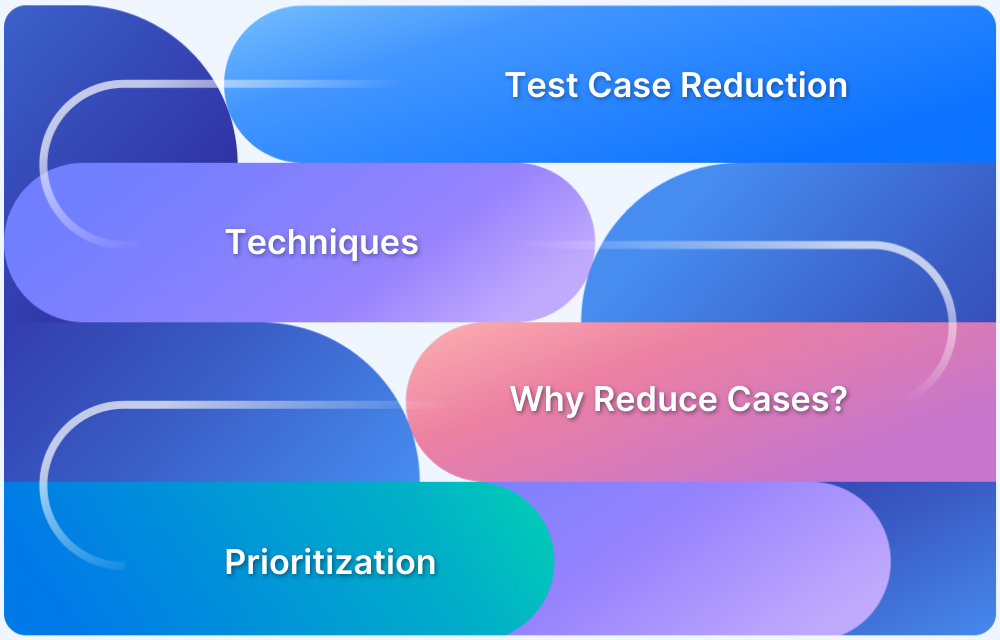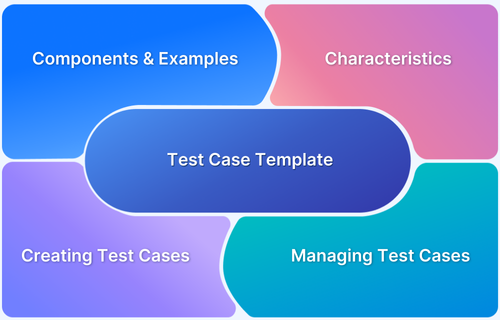AI-powered test case generators are transforming the way test cases are created by automating the generation process based on application behavior and input data. This approach accelerates testing cycles, reduces human error, and enhances the depth and scope of test coverage.
Overview
What is AI Test Case Generation?
AI-powered test case generation leverages machine learning and advanced algorithms to automatically create test cases by analyzing code, application behavior, and requirements.
Benefits of AI-Powered Test Case Generation:
- Enhanced Coverage: AI generates diverse test cases, covering a broader range of scenarios, including edge and corner cases.
- Faster Execution: Automates the test creation process, significantly reducing the time needed to generate test cases and speeding up the testing phase.
- Higher Accuracy: AI algorithms analyze code more thoroughly, producing more precise test cases and reducing the likelihood of human error.
- Cost-Efficient: Reduces manual intervention, lowering testing costs while maintaining or increasing test coverage.
- Adaptability: Automatically adjusts test cases in response to changes in the codebase, ensuring tests are always relevant and up-to-date.
- Improved Test Quality: AI enhances test quality by identifying issues that might be missed through manual testing, ensuring more robust application performance.
This article explores AI test case generation, its benefits, challenges, best practices, and how it compares to traditional test generation.
What is Test Case Generation?
Test case generation is the process of creating structured test cases that validate whether a software application behaves as expected under different conditions.
A test case typically includes inputs, execution steps, expected outcomes, and sometimes post-conditions. Traditionally, test cases are written manually by QA engineers who analyze requirements, user stories, or system specifications to design validation scenarios.
The goal of test case generation is to ensure comprehensive coverage across functional, non-functional, and edge scenarios so that defects can be detected early in the development cycle. Depending on the approach, test cases can be derived from:
- Requirements-based testing: Translating user stories or requirements into test steps.
- Model-based testing: Using system models (state machines, flowcharts) to generate test cases automatically.
- Code-based testing: Deriving test cases from the structure and behavior of the source code.
- Risk-based testing: Prioritizing test case creation based on potential failure impact.
By generating test cases systematically, teams can avoid gaps in coverage, maintain consistency in test design, and reduce the likelihood of missing critical defects during software delivery.
Understanding AI Test Case Generation
AI test case generation refers to the use of artificial intelligence, particularly machine learning (ML) and natural language processing (NLP), to automatically generate test cases from various inputs such as requirement documents, user stories, source code, or even production usage data.
Unlike traditional methods that rely heavily on manual effort and predefined models, AI-driven approaches can learn from historical test data, code repositories, and application behavior to dynamically create more accurate and relevant test cases.
How AI Test Case Generation Works
AI test case generation combines natural language processing, machine learning, and automation frameworks to transform requirements and application data into executable test cases. The process typically unfolds in a series of interconnected stages:
- Requirement Ingestion
- AI systems parse requirement documents, user stories, or acceptance criteria (often written in natural language).
- NLP models extract key actions, inputs, and expected outcomes that correspond to testable scenarios.
- Intent and Scenario Identification
- The system determines the functional intent behind the requirement (e.g., login, payment, search).
- It maps possible user flows and highlights edge, negative, and conditional scenarios.
- Data and Model Analysis
- ML algorithms analyze historical defect data, legacy test suites, and code coverage reports to suggest additional test cases that humans might miss.
- Model-based testing approaches may also leverage system diagrams or state machines where available.
- Test Case Construction
- AI converts identified scenarios into structured test cases with defined inputs, preconditions, steps, and expected outcomes.
- In many platforms, these can be exported into automation frameworks (e.g., Selenium, Cypress, or API testing tools).
- Continuous Learning and Updating
- Each time requirements, code, or user behavior changes, AI updates the existing test suite automatically.
- Reinforcement learning helps the system improve over time by observing which test cases found defects and which added the least value.
By automating these steps, AI ensures that test cases are not only generated faster but also kept up-to-date, reducing the common problem of obsolete or redundant tests in rapidly changing development environments.
Benefits of Using AI to Generate Test Cases
Using AI for test case generation offers significant advantages over traditional manual or scripted methods, enhancing both the efficiency and effectiveness of software testing:
- Faster Test Case Creation: AI accelerates the process by automatically generating comprehensive test cases from requirements or existing data, significantly reducing time spent on manual design.
- Improved Test Coverage: AI identifies edge cases, negative scenarios, and uncommon user paths that human testers might overlook, leading to better overall coverage and defect detection.
- Reduced Human Effort and Errors: Automating repetitive and complex tasks lowers the risk of human error and frees testers to focus on higher-value activities like exploratory testing and quality analysis.
- Adaptive and Scalable Testing: AI continuously updates test cases based on code changes, user feedback, and defect trends, ensuring tests remain relevant and scalable to complex software environments.
- Data-Driven Insights: Machine learning leverages historical defects and test results to prioritize critical test cases and optimize testing efforts, maximizing return on investment.
- Integration with Automation Tools: AI-generated test cases can often be seamlessly integrated into existing automation frameworks, enabling quicker execution cycles and continuous testing in CI/CD pipelines.
Challenges in AI Test Case Generation
Despite its transformative potential, AI test case generation faces several challenges that teams must be aware of to effectively leverage the technology:
- Limited Context Understanding: AI models may struggle to fully grasp the broader business context, user intent, and complex domain logic in requirements, leading to test cases that lack critical relevance or miss essential scenarios.
- Dependence on Large, Quality Data: Effective AI requires extensive, high-quality datasets for training. Insufficient or biased data can result in poor coverage, missed edge cases, or inaccurate tests.
- Accuracy and Consistency Issues: AI-generated test cases can sometimes produce false positives or false negatives, or inconsistent results because of probabilistic AI behavior, requiring human oversight for validation.
- Handling Complex and Dynamic Environments: AI may find it difficult to generate tests for complex systems with dynamic interfaces, real-time data, and integrations, which can limit test completeness.
- Maintenance and Model Drift: As software and AI models evolve, keeping test cases aligned requires continuous retraining and updates, which can be resource-intensive.
- Initial Setup and Cost: Implementing AI test case generation involves upfront investments in tools, integration, and training, which can be a barrier for some organizations.
- Transparency and Explainability: AI’s decision-making can be opaque, making it challenging to trace why certain test cases were generated, a concern especially in safety-critical or compliance-driven projects.
Why Choose BrowserStack AI for Test Case Generation?
The BrowserStack AI Test Case Generator is a specialized, purpose-built solution designed to automate and accelerate the creation of high-quality test cases within the software development lifecycle.
Unlike generic AI assistants, this agent is deeply integrated into the BrowserStack Test Management platform, leveraging context-aware insights from unified project data, including product requirements, user stories, and real test environments, to produce meaningful and actionable test scenarios.
Powered by advanced machine learning models, this agent comprehends both simple user stories and complex product requirement documents (PRDs), generating test cases that cover a wide range of scenarios. Key features include:
- Speed: Reduces test case creation time by over 90%, converting hours or days of manual effort into seconds-long automated generation.
- Actionable Output: Produces detailed test cases with clearly defined steps, preconditions, and expected results, ready for immediate use in manual and automated testing workflows.
- Flexible Input Methods: Supports diverse inputs, including quick text prompts, detailed requirement files (such as PDFs), Jira issues, and even annotated images, seamlessly fitting into existing documentation styles and workflows.
- Multiple Output Formats: Delivers test cases in plain English, step-based instructions, or Behavior Driven Development (BDD) Gherkin syntax, ensuring compatibility with various QA methodologies.
- Seamless Integration: Fully integrated with BrowserStack Test Management, allowing users to organize, manage, and execute test cases within a single unified platform.
- Scalable for Large Projects: Handles large, multi-feature PRDs up to 25 pages and 15MB files, making it suitable for enterprise-scale testing environments.
- Review and Customization: Enables inline editing and selection of AI-generated cases, empowering teams to tailor test suites to their unique needs.
- Traceability: Maintains links between test cases and their original requirements or Jira tickets, ensuring transparency and requirement coverage.
- Security and Privacy: Operates without training on customer data, preserving security and compliance standards typical of enterprise environments.
Best Practices for AI Test Case Generation
To maximize the effectiveness of AI-driven test case generation, teams should consider the following best practices:
- Provide Clear Requirements: Ensure requirements or user stories are detailed and unambiguous. This clarity helps AI generate more relevant and accurate test cases.
- Incorporate Historical Data: Feeding past test cases and defect histories into AI models helps improve coverage by learning from previous issues.
- Keep AI Models Updated: Regularly update AI training data to reflect changes in software and requirements to maintain test relevance.
- Integrate with CI/CD: Embed AI-generated tests in continuous integration/deployment pipelines to ensure testing keeps pace with development.
- Monitor Coverage and Duplicates: Use AI tools to track gaps and remove redundant test cases, keeping test suites efficient and focused.
Traditional vs. AI-Driven Test Generation
The table below highlights the key differences between traditional test case generation and AI-driven approaches.
| Aspect | Traditional Test Case Generation | AI-Driven Test Case Generation |
| Creation Method | Manual authoring of test cases based on requirements; time- and effort-intensive. | Automated generation from PRDs, user stories, or prompts using AI algorithms. |
| Speed and Efficiency | Slower process; dependent on human availability and skill. | Rapid creation with up to 90% reduction in test design time. |
| Maintenance | High maintenance due to manual updates required for UI/feature changes. | Self-healing and adaptive test cases reduce maintenance effort. |
| Coverage | Limited to pre-defined scenarios, often missing edge cases. | Broader test coverage, including edge cases and unexpected scenarios. |
| Accuracy and Consistency | Subject to human error and variability in test quality. | Consistent and high accuracy (up to 91%) leveraging contextual understanding. |
AI-driven test case generation significantly accelerates and enhances software testing by automating time-consuming manual tasks, improving test coverage, and adapting to changes, while traditional methods rely heavily on human effort and can struggle to keep pace with rapid application evolution.
Conclusion
AI-powered test case generation is revolutionizing software testing by significantly reducing manual effort, speeding up test creation, and improving overall test coverage. By leveraging AI to analyze requirements, historical data, and user stories, teams can generate smarter, more comprehensive test cases that help catch defects earlier and accelerate release cycles.
BrowserStack AI transforms test case generation by automating manual tasks, increasing test coverage, and accelerating test creation with high accuracy. This AI-driven approach empowers teams to deliver quality software faster while reducing effort and maintenance.








